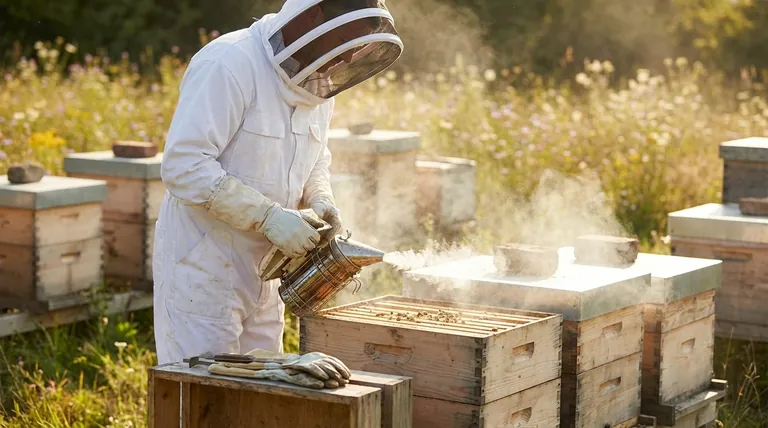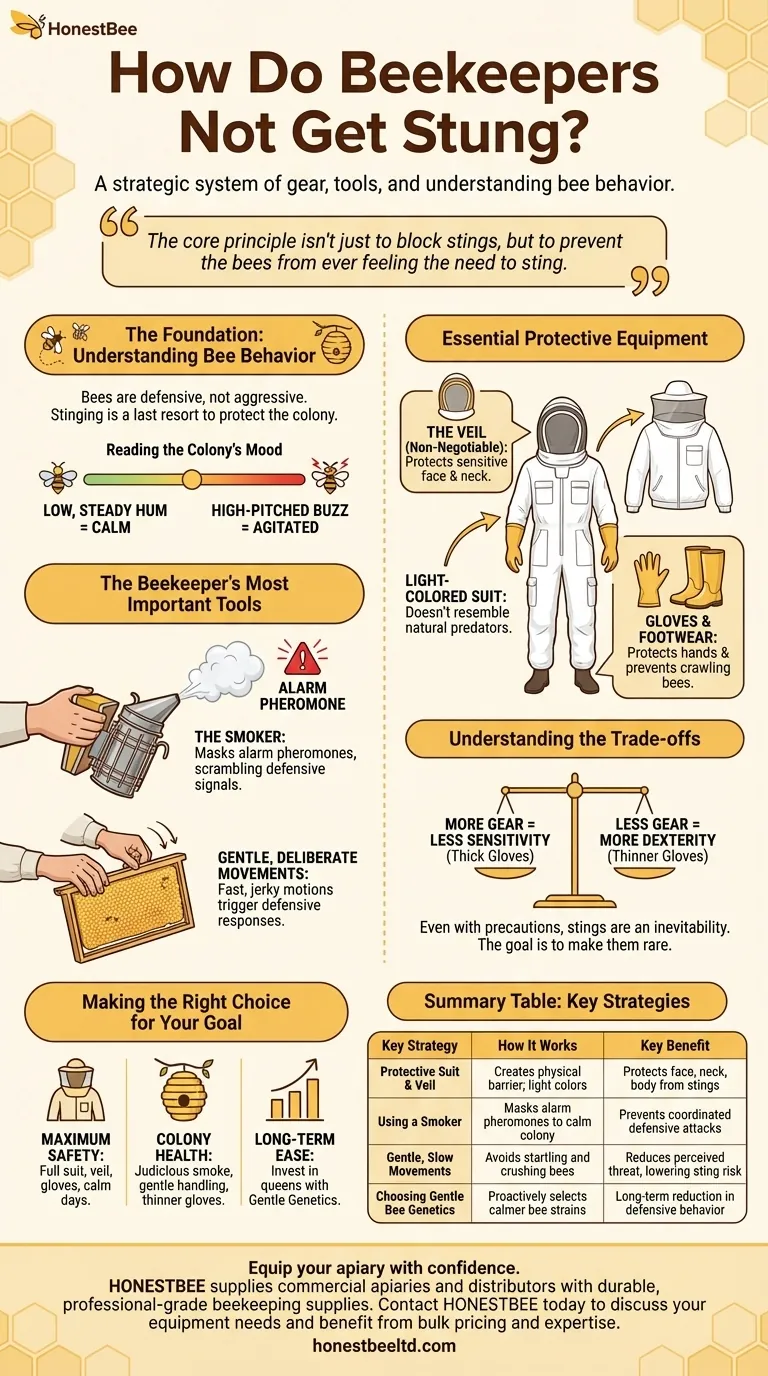The short answer is a strategic combination of specialized protective clothing, specific tools, and a deep understanding of bee behavior. Beekeepers don't rely on a single trick; they employ a system of techniques to minimize the bees' defensive response, making stings a rare event rather than a constant threat.
The core principle isn't just to block stings, but to prevent the bees from ever feeling the need to sting. This is achieved by masking their alarm signals, moving with deliberate calm, and choosing bees with gentler genetics.

The Foundation: Understanding Bee Behavior
To work with bees safely, one must first understand why they sting. Bees are not inherently aggressive; their sting is a purely defensive mechanism to protect their colony and resources from perceived threats.
Defense, Not Aggression
A bee stinging is its last resort. A honey bee dies after it stings a mammal, so it is a suicidal act used only to protect the hive's queen, brood, and honey stores. A beekeeper's primary goal is to signal that they are not a threat.
Reading the Colony's Mood
Beekeepers learn to interpret the sounds and activity of a hive. A low, steady hum is a sign of a calm colony, while a high-pitched, agitated buzz indicates that the bees are on high alert and it may be best to postpone the inspection.
Essential Protective Equipment
Physical protection is the most visible part of a beekeeper's safety strategy. While experienced beekeepers may occasionally use less gear, a full set is standard practice.
The Veil: The Non-Negotiable
The veil is the single most critical piece of equipment. It protects the face, head, and neck, which are sensitive areas and common targets for defensive bees. Forgoing a veil is an unnecessary risk for any beekeeper.
The Bee Suit or Jacket
A full bee suit or a jacket provides a thick barrier between the beekeeper's skin and the bees. They are typically white or a light color, as dark colors can be mistaken for a natural predator, like a bear, provoking a defensive response.
Gloves and Footwear
Gloves protect the hands, but they are a point of debate. While they offer excellent protection, some beekeepers find that thick gloves reduce their dexterity, making them less gentle when handling frames. Tall boots and taped trousers prevent bees from crawling up the legs.
The Beekeeper's Most Important Tools
Beyond clothing, a few key tools are essential for calm and safe hive inspections. These tools directly influence bee behavior.
The Smoker: Masking the Alarm
The smoker is a beekeeper's most important tool for managing a colony. Puffs of cool, white smoke mask the alarm pheromone that guard bees release when they perceive a threat. This pheromone would otherwise signal the entire colony to attack, so the smoke essentially scrambles their defensive communications.
Gentle and Deliberate Movements
Fast, jerky movements can startle bees and trigger a defensive response. Beekeepers learn to move slowly and deliberately when opening and inspecting a hive, avoiding crushing bees and handling the frames with care.
Understanding the Trade-offs
There is no single perfect approach, and beekeepers must balance protection with practicality. Understanding these compromises is key to effective beekeeping.
Gear vs. Sensitivity
More protection often means less sensitivity. Thick gloves prevent stings but can make a beekeeper clumsy, potentially harming bees and agitating the hive more than necessary. Experienced keepers often opt for thinner gloves or no gloves to improve their dexterity.
The Inevitability of Stings
Even with every precaution, virtually all beekeepers get stung eventually. A bee might get trapped in a fold of clothing, or a keeper might make a mistake. The goal is to make stings a manageable and infrequent occurrence, not to eliminate them entirely.
Making the Right Choice for Your Goal
Your approach to sting prevention depends on your experience level and the temperament of your bees.
- If your primary focus is maximum safety: Always wear a full suit with a veil, gloves, and proper footwear, and only work your bees on calm, sunny days.
- If your primary focus is colony health: Use smoke judiciously, move with extreme care to avoid crushing bees, and consider using thinner gloves to improve your gentle handling of the frames.
- If your primary focus is long-term ease of handling: Invest in queens with gentle genetics, as this proactive step makes every future hive inspection significantly calmer and safer.
Ultimately, preventing stings is a skill built on respect for the bees and a calm, methodical approach to working with them.
Summary Table:
| Key Strategy | How It Works | Key Benefit |
|---|---|---|
| Protective Suit & Veil | Creates a physical barrier; light colors avoid triggering defense. | Protects face, neck, and body from stings. |
| Using a Smoker | Masks alarm pheromones to calm the colony. | Prevents coordinated defensive attacks. |
| Gentle, Slow Movements | Avoids startling bees and crushing them. | Reduces perceived threat, lowering sting risk. |
| Choosing Gentle Bee Genetics | Proactively selects calmer bee strains. | Long-term reduction in defensive behavior. |
Equip your apiary with confidence. At HONESTBEE, we supply commercial apiaries and distributors with the durable, professional-grade beekeeping supplies mentioned in this article—from full-body bee suits and reliable smokers to veils and gloves designed for safety and dexterity.
Whether you're managing hundreds of hives or supplying equipment to fellow beekeepers, our wholesale-focused operations ensure you get the right gear to keep your teams safe and your colonies calm.
Contact HONESTBEE today to discuss your equipment needs and benefit from our bulk pricing and expertise.
Visual Guide

Related Products
- Cotton Beekeeping Suit and Round Hat with Veil Bee Keeper Protective Gear
- White Beekeeping Protective Suit and Hat with Fencing Veil for Beekeepers
- Heavy Duty Cowboy Beekeeper Hat with Visibility Veil Outdoor Professional Beekeeping Protective Gear
- Professional Beekeeping Suit for Kids and Girls Childrens Bee Keeper Suit
- Beekeeper Cowboy Hat and Veil for Beekeeping
People Also Ask
- How should a beekeeping suit be hung to maintain its shape? Protect Your Investment with Proper Storage
- What factors should be considered when choosing a beekeeping suit? Balance Safety, Comfort & Performance
- What is recommended for beginners in beekeeping regarding protective clothing? A Complete Safety Guide for New Beekeepers
- What are the benefits of a fully ventilated beekeeping suit? Stay Cool and Protected in Hot Climates
- Why is white the predominant color in bee suit designs? | Key to Hive Calm & Beekeeper Safety



















